Pioneer AVIC-F9220BT User Manual
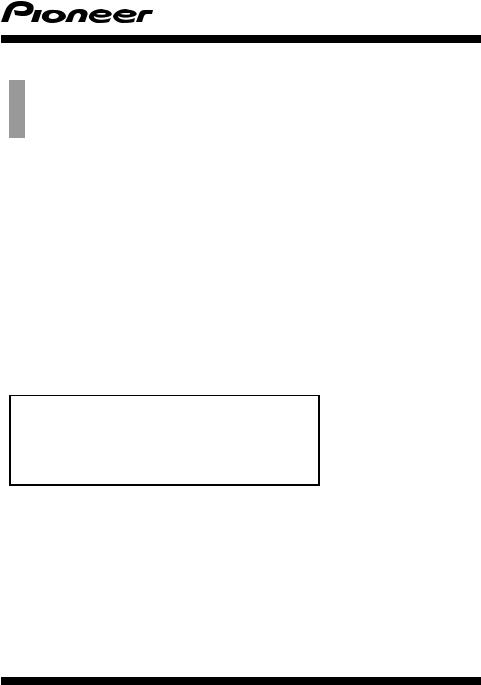
Operation Manual
NAVIGATION AV SYSTEM
AVIC-F20BT
AVIC-F920BT
AVIC-F9210BT
AVIC-F9220BT
Be sure to read Important Information for the User first!
Important Information for the User includes the important information that you must understand before using this navigation system.
English
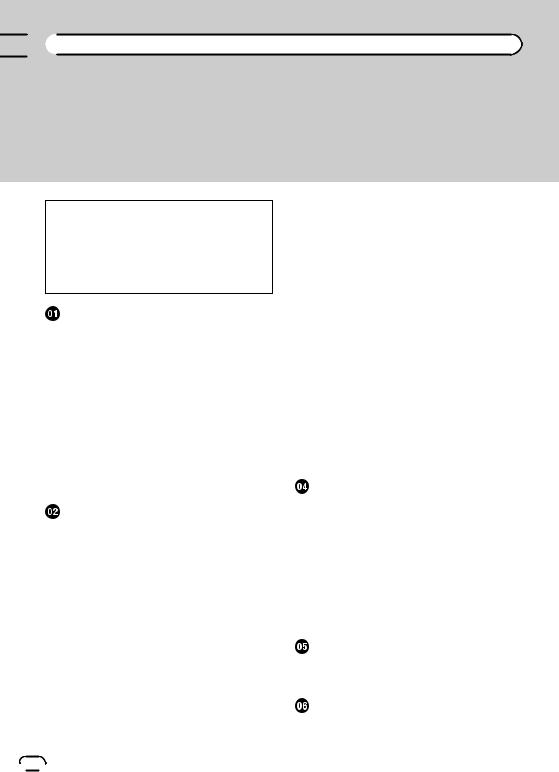

 Contents
Contents
Thank you for buying this Pioneer product.
Please read through these operating instructions so you will know how to operate your model properly. After you have finished reading the instructions, keep this manual in a safe place for future reference.
 Important
Important
The screens shown in the examples may differ from actual screens.
Actual screens may be changed without notice for performance and function improvements.
Introduction |
|
Manual overview 8 |
|
– |
How to use this manual 8 |
– |
Conventions used in this manual 8 |
– |
Terms used in this manual 8 |
Notice regarding video viewing |
9 |
|
|
|||
Notice regarding DVD-Video viewing |
9 |
|||||
Notice regarding MP3 file usage |
9 |
|
||||
iPod compatibility 9 |
|
|
|
|
||
Map coverage |
9 |
|
|
|
|
|
Protecting the LCD panel and screen |
10 |
|||||
Notes on internal memory |
10 |
|
|
|
||
– |
Before removing the vehicle |
|
|
|||
|
battery |
10 |
|
|
|
|
– |
Data subject to erasure |
10 |
|
|
||
Basic operation |
|
|
|
|
||
Checking part names and functions |
11 |
|||||
Adjusting the LCD panel angle |
13 |
|
||||
Inserting and ejecting a disc |
13 |
|
|
|||
– |
Inserting a disc (for AVIC-F20BT) |
13 |
||||
– |
Ejecting a disc (for AVIC-F20BT) |
14 |
||||
– |
Inserting a disc (for AVIC-F920BT, AVIC- |
|||||
|
F9210BT and AVIC-F9220BT) |
14 |
||||
– |
Ejecting a disc (for AVIC-F920BT, AVIC- |
|||||
|
F9210BT and AVIC-F9220BT) |
14 |
||||
Inserting and ejecting an SD memory |
|
|||||
card 15 |
|
|
|
|
|
|
–Inserting an SD memory card (for AVICF20BT) 15
–Ejecting an SD memory card (for AVICF20BT) 16
–Inserting an SD memory card (for AVICF920BT, AVIC-F9210BT and AVICF9220BT) 16
–Ejecting an SD memory card (for AVICF920BT, AVIC-F9210BT and AVICF9220BT) 17
Plugging and unplugging a USB storage
device 17 |
|
|
– |
Plugging in a USB storage device |
18 |
– |
Unplugging a USB storage device |
18 |
Connecting and disconnecting an iPod |
18 |
|
– |
Connecting your iPod 18 |
|
– |
Disconnecting your iPod 18 |
|
Flow from startup to termination 19
On first-time startup |
19 |
Regular startup 19 |
|
 How to use the navigation menu screens
How to use the navigation menu screens
Screen switching overview |
20 |
|
|
|
||
What you can do on each menu |
21 |
|
|
|||
Shortcut Menu |
21 |
|
|
|
|
|
– |
Selecting the shortcut |
21 |
|
|
|
|
– |
Cancelling the shortcut 22 |
|
|
|
||
Operating list screens (e.g. POI list) |
22 |
|
||||
Operating the on-screen keyboard |
22 |
|
||||
How to use the map |
|
|
|
|
||
How to read the map screen |
23 |
|
|
|
||
– |
Enlarged map of the intersection |
24 |
||||
– |
Display during motorway driving |
25 |
||||
Roads without turn-by-turn instructions |
25 |
|||||
Operating the map screen |
25 |
|
|
|
||
– |
Changing the scale of the map |
25 |
||||
– |
Switching the map orientation |
25 |
||||
– |
Scrolling the map to the position you |
|||||
|
want to see |
26 |
|
|
|
|
– |
Setting the “Quick Access” menu |
26 |
||||
Switching the view mode 27 |
|
|
|
|||
Eco-driving function |
|
|
|
|
||
Displaying “Eco Graph” 29 |
|
|
|
|
||
Displaying Eco Drive Level guidance |
30 |
|||||
Sudden start alert 30 |
|
|
|
|
||
Searching for and selecting a location |
||||||
The basic flow of creating your route |
31 |
|||||
Searching for a location by address |
32 |
|
||||
– |
Searching for a street name first |
32 |
||||
 2
2 Engb
Engb

 Contents
Contents
– |
Searching for a city name first 33 |
– |
Finding your destination by specifying |
|
the postcode 33 |
–Searching for a name by entering multiple keywords 34
Setting up a route to your home |
35 |
||
Searching for Points of Interest (POI) 35 |
|||
– |
Searching for POIs by preset |
||
|
categories |
35 |
|
– |
Searching for a POI directly from the |
||
|
name of the facilities 35 |
|
|
– |
Searching for a nearby POI |
36 |
|
– |
Searching for POIs around the |
||
|
destination |
36 |
|
– |
Searching for POIs around the city 37 |
||
Selecting destination from “Favourites” 37 Searching for POIs by using the data on the
SD memory card |
38 |
|
|
|
|
|
Selecting a location you searched for |
|
|||||
recently 38 |
|
|
|
|
|
|
Searching for a location by coordinates |
38 |
|||||
After the location is decided |
|
|
|
|||
Setting a route to your destination |
40 |
|
||||
– |
Display multiple routes |
40 |
|
|
||
Checking and modifying the current |
|
|||||
route |
|
|
|
|
|
|
Displaying the “Route Overview” screen |
41 |
|||||
Modifying the route calculation |
|
|
||||
conditions 41 |
|
|
|
|
|
|
– |
Items that users can operate |
41 |
|
|||
Checking the current itinerary |
42 |
|
|
|||
Editing waypoints |
43 |
|
|
|
|
|
– |
Adding a waypoint |
43 |
|
|
|
|
– |
Deleting a waypoint |
43 |
|
|
|
|
– |
Sorting waypoints |
44 |
|
|
|
|
Cancelling the route guidance |
44 |
|
|
|||
 Registering and editing locations
Registering and editing locations
Storing a location in “Favourites” 45
–Registering a location by “Favourites” 45
–Registering a location by scroll mode 45
Editing registered locations 45
– |
Editing the entry in the “Favourites” |
|
|
list |
45 |
– |
Editing your home 46 |
|
– |
Sorting the entry in the “Favourites” |
|
|
list |
46 |
–Deleting the entry from the “Favourites” list 47
Exporting and importing “Favourites” |
|
||
items |
47 |
|
|
– |
Exporting “Favourites” items 47 |
|
|
– |
Importing the “Favourites” items |
48 |
|
Deleting the entry from the “History” list |
48 |
||
Using traffic information |
|
||
Checking all traffic information 49 |
|
||
Checking traffic information on the |
|
||
route |
50 |
|
|
How to read traffic information on the |
|
||
map |
50 |
|
|
Setting an alternative route to avoid traffic |
|||
jams |
50 |
|
|
– |
Checking for traffic jams |
|
|
|
automatically 51 |
|
|
– |
Checking traffic information |
|
|
|
manually 51 |
|
|
Selecting traffic information to display 52 Selecting preferred RDS-TMC service
provider manually 52
 Registering and connecting a Bluetooth
Registering and connecting a Bluetooth
device |
|
|
|
Preparing communication devices |
53 |
||
Registering your Bluetooth devices |
53 |
||
– |
Searching for nearby Bluetooth |
||
|
devices |
53 |
|
– |
Pairing from your Bluetooth |
|
|
|
devices |
54 |
|
– |
Searching for a specified Bluetooth |
||
|
device |
55 |
|
– |
Deleting a registered device |
56 |
|
Engb  3
3


 Contents
Contents
Connecting a registered Bluetooth device 56
– Setting for priority connecting 57
 Using hands-free phoning
Using hands-free phoning
Displaying the Phone Menu 58
Making a phone call |
58 |
|
– |
Direct dialling |
58 |
– |
Making a call home easily 59 |
|
–Calling a number in the “Contacts List” 59
– |
Dialling from the history |
59 |
|
||
– |
Dialling the entry stored in the |
|
|||
|
“Favourites” list |
60 |
|
|
|
– |
Dialling a facility’s phone number 60 |
||||
– |
Dialling from the map |
60 |
|
||
Receiving a phone call |
61 |
|
|
||
– |
Answering an incoming call |
61 |
|||
Transferring the phone book |
61 |
|
|||
– |
Deleting registered contacts |
62 |
|||
Changing the phone settings |
63 |
|
|||
– |
Editing the device name |
63 |
|
||
– |
Editing the password 63 |
|
|||
– |
Stopping Bluetooth wave |
|
|||
|
transmission 63 |
|
|
||
– |
Echo cancelling and noise |
|
|||
|
reduction |
63 |
|
|
|
– |
Answering a call automatically 64 |
||||
– |
Setting the automatic rejection |
||||
|
function |
64 |
|
|
|
– |
Clearing memory |
64 |
|
|
|
–Updating the Bluetooth wireless technology software 65
Notes for hands-free phoning 65
 Basic operations of the AV source
Basic operations of the AV source
Displaying the AV operation screen 67
– |
Selecting a source |
67 |
Operating list screens (e.g. iPod list |
||
screen) 67 |
|
|
– Switching between the AV operation |
||
|
screen and the list screen 67 |
|
– |
Selecting an item |
68 |
– |
Returning to the previous display 68 |
|
Using the radio (FM) |
|
||
Starting procedure |
69 |
|
|
Reading the screen |
69 |
|
|
Using the touch panel keys |
70 |
||
– |
Storing and recalling broadcast |
||
|
frequencies |
71 |
|
– |
Using radio text 71 |
|
|
Using the “Function” menu |
72 |
||
– |
Storing the strongest broadcast |
||
|
frequencies |
72 |
|
– |
Tuning in strong signals 72 |
||
–Limiting stations to regional programming 73
–Searching for an RDS station by PTY
|
information |
73 |
|
|
– |
Receiving traffic announcements |
73 |
||
– Tuning into alternative frequencies |
74 |
|||
– |
Using news programme |
|
||
|
interruption |
74 |
|
|
– |
Interruption icon status |
75 |
|
|
– |
PTY list 76 |
|
|
|
Using the radio (AM) |
|
|
||
Starting procedure |
77 |
|
|
|
Reading the screen |
77 |
|
|
|
Using the touch panel keys |
78 |
|
||
– |
Storing and recalling broadcast |
|
||
|
frequencies |
78 |
|
|
Using the “Function” menu |
79 |
|
||
– |
Stores the strongest broadcast |
|
||
|
frequencies |
79 |
|
|
– Tunes in strong signals |
79 |
|
||
Playing audio CDs |
|
|
||
Starting procedure |
80 |
|
|
|
Reading the screen |
80 |
|
|
|
Using the touch panel keys |
81 |
|
||
Using the “Function” menu |
82 |
|
||
Playing music files on ROM |
|
|||
Starting procedure |
83 |
|
|
|
Reading the screen |
83 |
|
|
|
Using the touch panel keys |
85 |
|
||
Using the “Function” menu |
86 |
|
||
 4
4 Engb
Engb
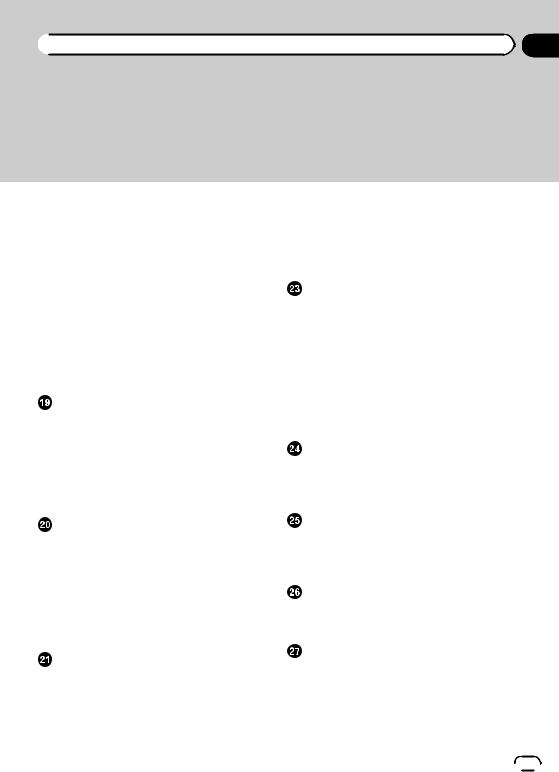
 Contents
Contents
 Playing a DVD-Video
Playing a DVD-Video
Starting procedure |
87 |
Reading the screen |
87 |
Using the touch panel keys 88
– Resuming playback (Bookmark) 89
–Searching for a specific scene and starting playback from a specified
|
time |
90 |
|
|
|
– |
Direct number search |
90 |
|
||
– |
Operating the DVD menu |
90 |
|||
– |
Using DVD menu by touch panel |
||||
|
keys |
90 |
|
|
|
– |
Frame-by-frame playback |
91 |
|||
– |
Slow motion playback |
91 |
|
||
Using the “Function” menu |
91 |
|
|||
Playing a DivX video |
|
|
|||
Starting procedure |
93 |
|
|
||
Reading the screen |
93 |
|
|
||
Using the touch panel keys |
94 |
|
|||
– |
Frame-by-frame playback |
95 |
|||
– |
Slow motion playback |
95 |
|
||
–Starting playback from a specified time 96
Using the “Function” menu |
96 |
|
|
||
DVD-Video or DivX setup |
|
|
|
||
Displaying DVD/DivX® Setup menu |
97 |
||||
Setting the top-priority languages 97 |
|||||
Setting the angle icon display |
97 |
|
|||
Setting the aspect ratio |
97 |
|
|
|
|
Setting the parental lock |
98 |
|
|
|
|
– Setting the code number and level 98 |
|||||
Setting the auto play |
99 |
|
|
|
|
Setting the subtitle file for DivX |
99 |
|
|||
Language code chart for DVDs |
100 |
|
|||
Playing music files (from USB or SD) |
|||||
Starting procedure |
101 |
|
|
|
|
Reading the screen |
101 |
|
|
|
|
Using the touch panel keys (Music) |
103 |
||||
Using the “Function” menu |
104 |
|
|||
 Playing video files (from USB or SD)
Playing video files (from USB or SD)
Starting procedure 105
Reading the screen 105
Using the touch panel keys (Video) 106
–Searching for a specific scene and starting playback from a specified time 107
Using the “Function” menu |
107 |
|
|
|||
Using an iPod (iPod) |
|
|
|
|||
Starting procedure |
108 |
|
|
|
||
Reading the screen |
108 |
|
|
|
||
Using the touch panel keys |
110 |
|
|
|||
Starting the video playback |
112 |
|
|
|||
Narrowing down a song or video with the |
||||||
list |
112 |
|
|
|
|
|
Operating the functions from your iPod |
113 |
|||||
Playing MusicSphere 114 |
|
|
|
|||
– |
Reading the screen |
114 |
|
|
||
– Using the touch panel keys |
114 |
|
||||
Using the “Function” menu |
114 |
|
|
|||
Using the Bluetooth audio player |
|
|||||
Starting procedure |
116 |
|
|
|
||
Reading the screen |
116 |
|
|
|
||
Using the touch panel keys |
118 |
|
|
|||
Using the “Function” menu |
118 |
|
|
|||
Using AV input |
|
|
|
|
||
Reading the screen |
120 |
|
|
|
||
Using AV1 |
120 |
|
|
|
|
|
Using AV2 |
120 |
|
|
|
|
|
Using the touch panel keys |
120 |
|
|
|||
Using the external unit (EXT1, EXT2) |
||||||
Starting procedure |
121 |
|
|
|
||
Reading the screen |
121 |
|
|
|
||
Using the touch panel keys |
122 |
|
|
|||
Customising preferences |
|
|
|
|||
Displaying the “Navi Settings” screen |
123 |
|||||
Checking the connections of leads |
123 |
|||||
Checking sensor learning status and driving status 124
– Clearing status 124
Using the “Fuel cons.” function 125
Engb  5
5


 Contents
Contents
–Inputting the fuel consumption information for calculating the fuel
cost 125
– Calculating the fuel consumption 126
–Exporting the data of fuel cost information 126
Recording your travel history |
127 |
|
|
|
Using the demonstration guidance |
127 |
|||
Registering your home |
127 |
|
|
|
Correcting the current location |
128 |
|
||
Changing the eco-function setting |
128 |
|||
Displaying the “Map Settings” screen |
129 |
|||
Setting the auto-zoom display |
129 |
|
|
|
Setting the detailed city map |
130 |
|
|
|
Setting the barrier graphic for city map |
130 |
|||
Setting the speed limit display |
130 |
|
|
|
Displaying the traffic notification icon |
130 |
|||
Displaying the Bluetooth connection |
|
|||
icon 131 |
|
|
|
|
Setting the current street name display |
131 |
|||
Setting the “Favourites” icon display |
131 |
|||
Displaying the 3D landmarks |
131 |
|
|
|
Displaying manoeuvres |
132 |
|
|
|
Displaying the fuel consumption information 132
Displaying POI on the map 132
–Displaying preinstalled POIs on the map 133
– Displaying the customised POIs 133 Changing “View Mode” 134
Setting the map colour change between day and night 134
Changing the road colour 134 Changing the setting of navigation
interruption screen 135
Selecting the “Quick Access” menu 135 Displaying the “System Settings”
screen 136
– Customising the regional settings 136
–Setting the Volume for Guidance and Phone 138
–Changing the preinstalled splash screen 139
– |
Changing to the splash screen stored |
|
in the SD memory card 139 |
– |
Setting for rear view camera 140 |
–Adjusting the response positions of the touch panel (touch panel
|
calibration) 141 |
– |
Setting the illumination colour 141 |
– |
Checking the version information 142 |
Selecting the video for “Rear display” 142 Adjusting the picture 143
Displaying the “AV System Settings”
screen 144 |
|
|
||
– |
Setting video input 1 (AV1) |
144 |
||
– |
Setting video input 2 (AV2) |
144 |
||
– |
Changing the wide screen mode 145 |
|||
– |
Setting the rear output |
145 |
|
|
– |
Switching the muting/attenuation |
|||
|
timing |
146 |
|
|
– |
Switching the muting/attenuation |
|||
|
level |
146 |
|
|
– |
Switching Auto PI seek |
146 |
||
– |
Setting the FM tuning step |
147 |
||
–Displaying your DivX VOD registration code 147
Displaying the “AV Sound Settings”
screen 147 |
|
|
|
– |
Using balance adjustment 148 |
||
– |
Using the equaliser |
148 |
|
– |
Adjusting loudness |
150 |
|
– |
Using subwoofer output |
150 |
|
– |
Using the high pass filter |
150 |
|
– |
Adjusting source levels |
151 |
|
– |
Enhancing bass (Bass Booster) 151 |
||
–Setting the simulated sound stage 151
Replicating the settings |
152 |
Setting the safe mode |
152 |
Turning off the screen |
152 |
 Operating Your Navigation System with Voice
Operating Your Navigation System with Voice
To ensure safe driving 153 Basics of Voice Operation 153
– Flow of voice operation 153
 6
6 Engb
Engb

 Contents
Contents
– |
Starting voice operation 153 |
|
– |
How to use the voice operation |
154 |
Available basic voice commands 156 |
||
– |
Basic commands 156 |
|
– |
Voice operation for AV source |
156 |
–Voice commands related to hands-free phoning 157
Tips for Voice Operation 157 |
|
||
Other functions |
|
|
|
Setting the anti-theft function |
158 |
||
– |
Setting the password |
158 |
|
– |
Entering the password |
158 |
|
– |
Deleting the password |
158 |
|
– |
Forgotten password |
158 |
|
Returning the navigation system to the
default or factory settings |
159 |
|
– |
Setting items to be deleted 160 |
|
– |
Restore Factory Settings |
161 |
–Displaying the “Select Items to Reset” screen 161
Appendix |
|
|
|
Troubleshooting 162 |
|
|
|
Messages and how to react to them |
167 |
||
Messages for audio functions 169 |
|
||
Positioning technology |
171 |
|
|
– |
Positioning by GPS |
171 |
|
– |
Positioning by dead reckoning |
171 |
|
–How do GPS and dead reckoning work together? 171
Handling large errors 172
– When positioning by GPS is impossible 172
–Conditions likely to cause noticeable positioning errors 173
Route setting information |
175 |
|
– |
Route search specifications 175 |
|
Handling and care of discs |
175 |
|
– |
Built-in drive and care |
176 |
– |
Ambient conditions for playing a |
|
|
disc 176 |
|
Playable discs 176 |
|
|
– |
DVD-Video and CD 176 |
|
– |
AVCHD recorded discs 176 |
|
– |
Playing DualDisc 177 |
|
– |
Dolby Digital |
177 |
– |
DTS sound |
177 |
Detailed information for playable media 177
– |
Compatibility |
177 |
– |
Media compatibility chart 180 |
|
Bluetooth 184 |
|
|
SD and SDHC logo |
184 |
|
WMA/WMV 184 |
|
|
DivX |
185 |
|
AAC |
185 |
|
Detailed information regarding connectable
iPods |
185 |
– iPod |
185 |
–iPhone 186
–iTunes 186
Using the LCD screen correctly |
186 |
|
– |
Handling the LCD screen |
186 |
– |
Liquid crystal display (LCD) |
|
|
screen 186 |
|
– |
Maintaining the LCD screen 186 |
|
–LED (light-emitting diode) backlight 186
Display information |
188 |
|
– |
Destination Menu 188 |
|
– |
Phone Menu |
188 |
– |
Settings Menu |
189 |
Glossary 193
Specifications 196
Engb  7
7

Chapter |
|
01 |
Introduction |
Manual overview
Before using this product, be sure to read Important Information for the User (a separate manual) which contains warnings, cautions, and other important information that you should note.
How to use this manual
Finding the operation procedure for what you want to do
When you have decided what you want to do, you can find the page you need from the Contents.
Finding the operation procedure from a menu name
If you want to check the meaning of an item displayed on the screen, you will find the necessary page from the Display information at the end of the manual.
Glossary
Use the glossary to find the meanings of terms.
Conventions used in this manual
Before moving on, take a few minutes to read the following information about the conventions used in this manual. Familiarity with these conventions will help you greatly as you learn how to use your new equipment.
!Buttons on your navigation system are described in ALL CAPITAL, BOLD lettering: e.g.)
MENU button, MAP button.
!Items in different menus, screen titles, and functional components are described in bold with double quotation marks “ ”: e.g.)
“Destination Menu” screen or “AV Source” screen
!Touch panel keys that are available on the screen are described in bold in brackets [ ]:
e.g.)
[Destination], [Settings].
!Extra information, alternatives and other notes are presented in the following format:
e.g.)
p If the home location has not been stored yet, set the location first.
!Descriptions of separate operations to be performed on the same screen are indicated with # at the beginning of the description:
e.g.)
# Touch [OK].
!References are indicated like this: e.g.)
= For details, refer to How to use the navigation menu screens on page 20.
Terms used in this manual
“Front Display” and “Rear Display”
In this manual, the screen that is attached to the body of this navigation unit will be referred to as the “Front Display”. Any additional optional screen that is purchased for use in conjunction with this navigation unit will be referred to as the “Rear Display”.
“Video image”
“Video image” in this manual indicates moving images of DVD-Video, DivX®, iPod, and any equipment that is connected to this system with an RCA cable, such as general-purpose AV equipment.
“External storage device (USB, SD)”
The SD memory card, SDHC memory card, microSD card, microSDHC card and USB memory device are collectively referred to as the “external storage device (USB, SD)”. If it indicates the USB memory only, it is referred to as the “USB storage device”.
 8
8 Engb
Engb

|
Chapter |
Introduction |
01 |
“SD memory card”
The SD memory card, SDHC memory card, microSD card and microSDHC card are collectively referred to as the “SD memory card”.
Notice regarding video viewing
Remember that use of this system for commercial or public viewing purposes may constitute an infringement on the author’s rights as protected by the Copyright Law.
Notice regarding DVDVideo viewing
This product incorporates copyright protection technology that is protected by method claims of certain U.S. patents and other intellectual property rights owned by Macrovision Corporation and other rights owners. Use of this copyright protection technology must be authorised by Macrovision Corporation, and is intended for home and other limited viewing uses only unless otherwise authorised by Macrovision Corporation. Reverse engineering or disassembly is prohibited.
Notice regarding MP3 file usage
Supply of this navigation system conveys only a licence for private, non-commercial use and does not convey a licence nor imply any right to use this product in any commercial (i.e. rev- enue-generating), real time broadcasting (terrestrial, satellite, cable and/or any other media), broadcasting/streaming via internet, intranets and/or other networks or in other electronic content distribution systems, such as pay-audio or audio-on-demand applications. An independent licence for such use is
required. For details, please visit http://www.mp3licensing.com.
iPod compatibility
This product supports only the following iPod models and iPod software versions. Others may not work correctly.
!iPod nano first generation: Ver. 1.3.1
!iPod nano second generation: Ver. 1.1.3
!iPod nano third generation: Ver. 1.1.3
!iPod nano fourth generation: Ver. 1.0.3
!iPod nano fifth generation: Ver. 1.0.1
!iPod fifth generation: Ver. 1.3
!iPod classic: Ver. 2.0.2
!iPod touch first generation: Ver. 3.1.1
!iPod touch second generation: Ver. 3.1.1
!iPhone: Ver. 3.1.2
!iPhone 3G: Ver. 3.1.2
!iPhone 3GS: Ver. 3.1.2
p In this manual, iPod and iPhone will be referred to as iPod.
pWhen you use this navigation system with a Pioneer USB interface cable for iPod (CDIU50V) (sold separately), you can control an iPod compatible with this navigation sys-
tem.
p To obtain maximum performance, we recommend that you use the latest software for the iPod.
pOperation methods may vary depending on the iPod models and the software version of iPod.
pFor details about iPod compatibility with this navigation system, refer to the information on our website.
piPod is a trademark of Apple Inc., registered in the U.S. and other countries.
p iPhone is a trademark of Apple Inc. 

Map coverage
For details about the map coverage of this navigation system, refer to the information on our website.
Introduction
Engb  9
9

Chapter
01  Introduction
Introduction
Protecting the LCD panel and screen
pDo not allow direct sunlight to fall on the LCD screen when this product is not being used. Extended exposure to direct sunlight
can result in LCD screen malfunction due to the resulting high temperatures.
pWhen using a mobile phone, keep the aerial of the mobile phone away from the LCD screen to prevent disruption of the video in
the form of spots, coloured stripes, etc.
pTo protect the LCD screen from damage, be sure to touch the touch panel keys with
your finger only and gently touch the screen.
Notes on internal memory
Before removing the vehicle battery
If the battery is disconnected or discharged, the memory will be erased and must be reprogrammed.
pSome data remains. Be sure to read Returning the navigation system to the default or factory settings first.
=For detailed information about the items which would be erased, refer to Returning the navigation system to the default or factory settings on page 159.
Data subject to erasure
The information is erased by disconnecting the yellow lead from the battery (or removing the battery itself). However, some items remain.
pSome data remains. Be sure to read Returning the navigation system to the default or factory settings first.
=For detailed information about the items which would be erased, refer to Return-
ing the navigation system to the default or factory settings on page 159.
 10
10 Engb
Engb
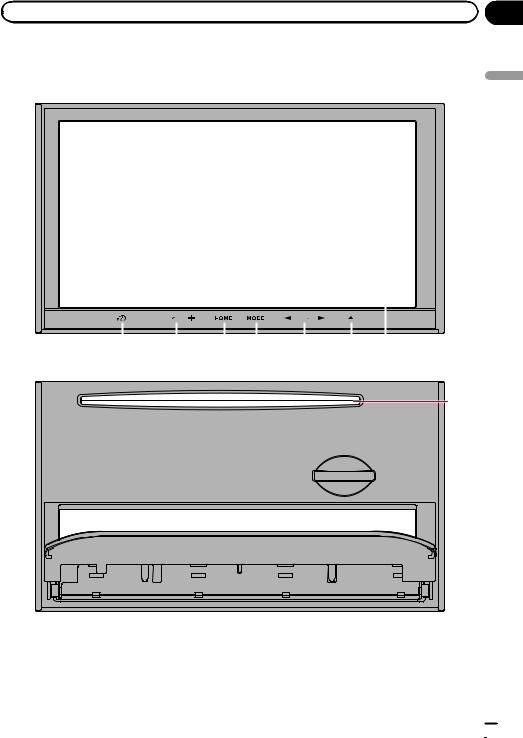
|
Chapter |
Basic operation |
02 |
Checking part names and functions
This chapter gives information about the names of the parts and the main features using the buttons.
operation Basic
|
|
|
|
|
|
|
|
|
|
|
|
|
|
|
|
|
|
|
|
|
|
|
|
|
|
|
|
|
|
|
|
|
|
|
|
|
|
|
|
|
|
|
|
|
|
|
|
|
|
|
|
|
|
|
|
|
|
|
|
|
|
|
|
|
|
|
|
|
|
|
|
|
|
|
|
|
|
|
|
|
|
|
|
|
|
|
|
1 |
2 |
3 |
4 |
5 |
6 |
7 |
|||||||||||||||
AVIC-F20BT (with the LCD panel closed)
8
 9
9
AVIC-F20BT (with the LCD panel open)
Engb  11
11

Chapter
02  Basic operation
Basic operation
6 |
8 |
9 |
2 |
|
|
3 |
|
|
|
|
7 |
4 |
|
|
5 |
|
|
1 |
|
|
AVIC-F920BT |
|
|
|
8 |
9 |
1 |
|
6 |
3 |
|
4 |
|
|
7 |
2 |
|
5 |
AVIC-F9210BT, AVIC-F9220BT |
|
|
1
 button
button
!AVIC-F20BT
Press the 
 button to activate voice operations.
button to activate voice operations.
!AVIC-F920BT, AVIC-F9210BT, AVIC-
F9220BT
Press the 
 button to hear the next guidance.
button to hear the next guidance.
Press and hold the 
 button to switch the AV source to mute.
button to switch the AV source to mute.
To cancel the muting, press and hold it again.
2 VOL (+/–) button
Press to adjust the AV (Audio and Video) source volume.
 12
12 Engb
Engb
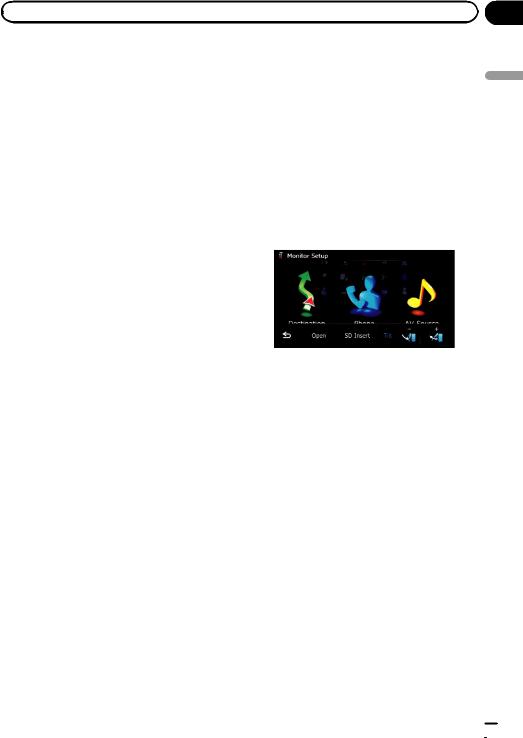
|
Chapter |
Basic operation |
02 |
3HOME button
!Press the HOME button to display the
“Top Menu” screen.
!Press to switch between the “Classic Menu” and the “Shortcut Menu” while the “Top Menu” is displayed.
=For details, refer to What you can do on each menu on page 21.
!Press and hold to turn off the screen display.
4MODE button
!Press to switch between the map screen and the AV operation screen.
!Press to display the map screen while the navigation function screen is displayed.
!Press and hold to display the “Picture Adjustment” screen.
=For details, refer to Adjusting the picture on page 143.
5TRK button
Press to perform manual seek tuning, fast forward, reverse and track search controls.
=For details, refer to the descriptions from Chapter 14 to Chapter 26.
6hbutton
7LCD screen
8Disc loading slot
Insert a disc to play.
=For details of the operation, refer to Inserting and ejecting a disc on this page.
9SD card slot
=For more detailed information, refer to In-
serting and ejecting an SD memory card on page 15.
Adjusting the LCD panel angle
pThis function is available for AVIC-F20BT only.
 WARNING
WARNING
When opening, closing and adjusting the angle of the LCD panel, be careful not to get your fingers caught.
 CAUTION
CAUTION
Do not open or close the LCD panel by force. This may cause malfunction.
1 Press the hbutton.
The “Monitor Setup” screen appears.
2 Touch  or
or  to adjust the angle.
to adjust the angle.
3 Touch  .
.
pThe adjusted angle of the LCD panel will be memorised and the LCD panel will automa-
tically return to that angle the next time the LCD panel is opened or closed.
Inserting and ejecting a disc
Inserting a disc (for AVIC-F20BT)
pThis section describes operations for AVICF20BT.
 WARNING
WARNING
!When opening, closing and adjusting the angle of the LCD panel, be careful not to get your fingers caught.
!Do not use with the LCD panel left open. If LCD panel is left open, it may result in injury in the event of an accident.
operation Basic
Engb  13
13
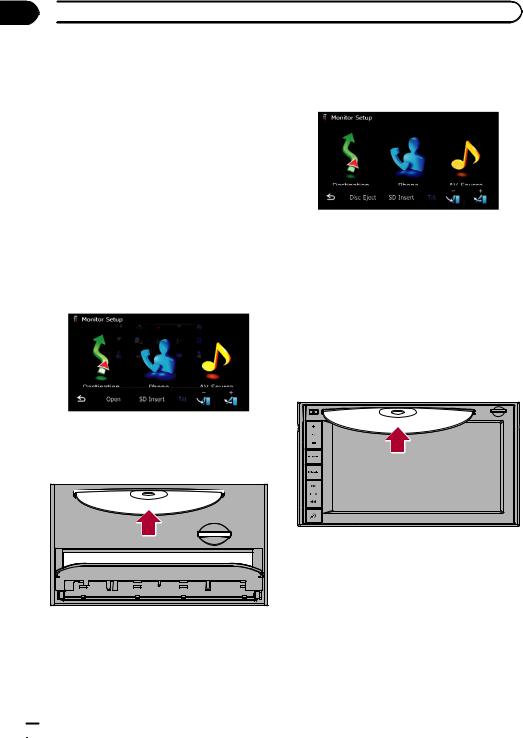
Chapter
02  Basic operation
Basic operation
 CAUTION
CAUTION
!Do not open or close the LCD panel by force. This may cause malfunction.
!Do not operate this navigation system until the LCD panel completely opens or closes. If this navigation system is operated while the LCD panel is opening or closing, the LCD panel may stop at that angle for safety.
!Do not place a glass or a can on the open LCD panel. Doing so may break this navigation system.
!Do not insert anything other than a disc into the disc loading slot.
1 Press the hbutton.
The “Monitor Setup” screen appears.
2 Touch [Open].
1 Press the hbutton.
The “Monitor Setup” screen appears.
2 Touch [Disc Eject].
The LCD panel opens, and the disc is ejected.
3 Remove the disc, and press the hbutton.
The LCD panel closes.
The LCD panel opens, and the disc loading slot appears.
3 Insert a disc into the disc loading slot.
The disc is loaded, and the LCD panel closes.
Ejecting a disc (for AVIC-F20BT)
pThis section describes operations for AVICF20BT.
Inserting a disc (for AVIC-F920BT, AVIC-F9210BT and AVIC-F9220BT)
pThis section describes operations for AVICF920BT, AVIC-F9210BT, and AVIC-F9220BT.
% Insert a disc into the disc loading slot.
pDo not insert anything other than a disc into the disc loading slot.
Ejecting a disc (for AVIC-F920BT, AVIC-F9210BT and AVIC-F9220BT)
pThis section describes operations for AVICF920BT, AVIC-F9210BT, and AVIC-F9220BT.
1 Press the hbutton.
The touch panel keys for ejecting the media appear.
 14
14 Engb
Engb
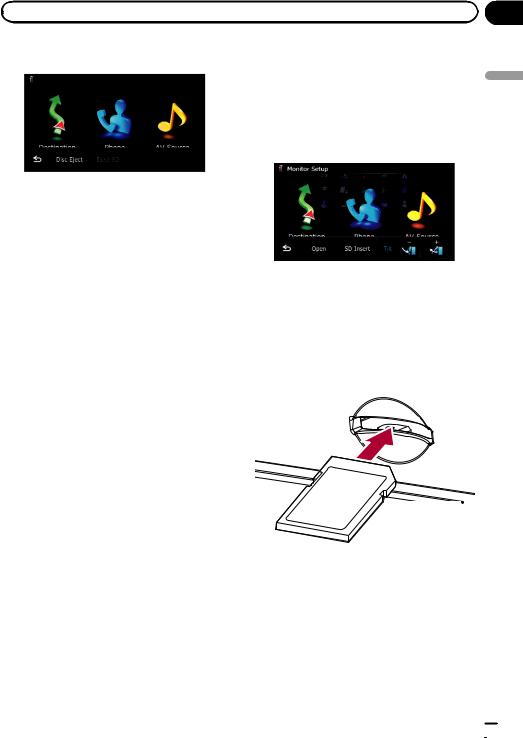
|
Chapter |
Basic operation |
02 |
2 Touch [Disc Eject].
The disc is ejected.
Inserting and ejecting an SD memory card
 WARNING
WARNING
Ejecting an SD memory card during data transfer can damage the SD memory card. Be sure to eject the SD memory card by following the procedure described in this manual.
 CAUTION
CAUTION
If data loss or corruption occurs on the storage device for any reason, it is usually not possible to recover the data. Pioneer accepts no liability for damages, costs or expenses arising from data loss or corruption.
pThis system is not compatible with Multi Media Card (MMC).
p Compatibility with all SD memory cards is not guaranteed.
pThis unit may not achieve optimum performance with some SD memory cards.
Inserting an SD memory card (for AVIC-F20BT)
pThis section describes operations for AVICF20BT.
 CAUTION
CAUTION
!Do not press the hbutton when an SD memory card is not fully inserted. Doing so may damage the card.
!Do not press the hbutton before an SD memory card has been completely removed. Doing so may damage the card.
1 Press the hbutton.
The “Monitor Setup” screen appears.
2 Touch [SD Insert].
The LCD panel opens, and the SD card slot appears.
3 Insert an SD memory card into the SD card slot.
Insert it with the label surface facing to the upside and press the card until it clicks and completely locks.
4 Press the hbutton.
The LCD panel closes.
pIf data related to map data, such as customised POI data, is stored on the SD memory card, the navigation system restarts.
operation Basic
Engb  15
15
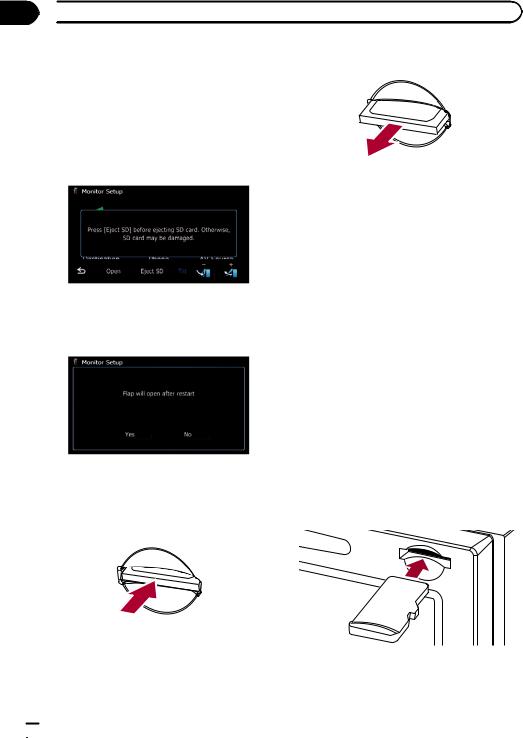
Chapter
02  Basic operation
Basic operation
Ejecting an SD memory card (for AVIC-F20BT)
pThis section describes operations for AVICF20BT.
1 Press the hbutton.
The “Monitor Setup” screen appears.
2 Touch [Eject SD].
The LCD panel opens.
pTouch [Yes] if the message indicating that the flap opens after the navigation system restarts appears.
4 Pull the SD memory card out straight.
5 Press the hbutton.
The LCD panel closes.
pIf data related to map data, such as customised POI data, is stored on the SD memory card, the navigation system restarts.
pWhen you eject the SD memory card by touching [Eject SD], the model information that you are using will be automatically stored into the SD memory card.
The utility programme navgate FEEDS will use this information to recognise the model that you use.
The navigation system restarts, and then the LCD panel opens.
3 Press the middle of the SD memory card gently until it clicks.
Inserting an SD memory card (for AVIC-F920BT, AVIC-F9210BT and AVIC-F9220BT)
pThis section describes operations for AVICF920BT, AVIC-F9210BT, and AVIC-F9220BT.
% Insert an SD memory card into the SD card slot.
Insert the SD memory card with the terminal contacts facing down, and press the card until it clicks and locks completely.
pIf data related to map data, such as customised POI data, is stored on the SD memory card, the navigation system restarts.
 16
16 Engb
Engb
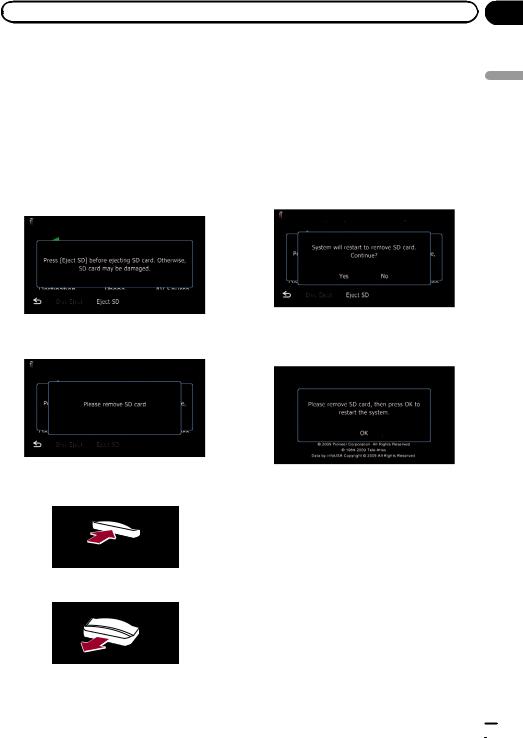
|
Chapter |
Basic operation |
02 |
Ejecting an SD memory card (for AVIC-F920BT, AVIC-F9210BT and AVIC-F9220BT)
pThis section describes operations for AVICF920BT, AVIC-F9210BT, and AVIC-F9220BT.
1 Press the hbutton.
The touch panel keys for ejecting the media appear.
2 Touch [Eject SD].
A message prompting you to remove the SD memory card appears.
3 Press the middle of the SD memory card gently until it clicks.
4 Pull the SD memory card out straight.
When the data related to map data is stored
If data related to map data, such as customised POI data, is stored on the SD memory card, operating procedures are slightly different.
1Press the hbutton and then touch [Eject SD].
2Touch [Yes].
The navigation system restarts, and a message prompting you to remove the SD memory card appears.
3Eject the SD memory card while the message is displayed.
Eject the SD memory card before touching [OK].
4Touch [OK].
The navigation system restarts.
Plugging and unplugging a USB storage device
 CAUTION
CAUTION
!To prevent data loss and damage to the storage device, never remove it from this navigation system while data is being transferred.
operation Basic
Engb  17
17

Chapter
02  Basic operation
Basic operation
!If data loss or corruption occurs on the storage device for any reason, it is usually not possible to recover the data. Pioneer accepts no liability for damages, costs or expenses arising from data loss or corruption.
Plugging in a USB storage device
% Plug a USB storage device into the USB connector.
USB connector
no liability for damages, costs or expenses arising from data loss or corruption.
Connecting your iPod
Using the USB interface cable for iPod enables you to connect your iPod to the navigation system.
pA USB interface cable for iPod (CD-IU50V) (sold separately) is required for connection.
1 Pull out the USB storage device after checking that no data is being accessed.
USB storage device
pCompatibility with all USB storage devices is not guaranteed.
This navigation system may not achieve optimum performance with some USB sto-
rage devices.
p Connection via a USB hub is not possible.
Unplugging a USB storage device
% Pull out the USB storage device after checking that no data is being accessed.
Connecting and disconnecting an iPod
 CAUTION
CAUTION
!To prevent data loss and damage to the storage device, never remove it from this navigation system while data is being transferred.
!If data loss or corruption occurs on the storage device for any reason, it is usually not possible to recover the data. Pioneer accepts
USB and mini-jack |
USB interface cable |
connector |
for iPod |
pFor details about iPod compatibility with this navigation system, refer to the informa-
tion on our website.
p Connection via a USB hub is not possible.
2 Connect your iPod.
Disconnecting your iPod
% Pull out the USB interface cable for iPod after checking that no data is being accessed.
 18
18 Engb
Engb
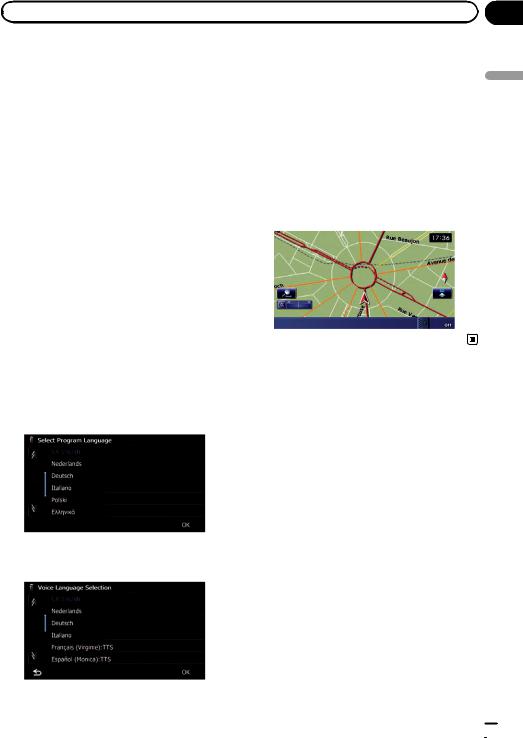
|
Chapter |
Basic operation |
02 |
Flow from startup to termination
1Start the engine to boot up the system.
After a short pause, the splash screen comes on for a few seconds.
p To protect the LCD screen from damage, be sure to touch the touch panel keys with your finger only and gently touch the screen.
2Turn off the vehicle engine to termi-
nate the system.
The navigation system is also turned off.
On first-time startup
When you use the navigation system for the first time, select the language that you want to use.
1Start the engine to boot up the system.
After a short pause, the splash screen comes on for a few seconds.
2Touch the language that you want to use on the screen.
3 Touch the language that you want to use for the voice guidance.
The navigation system will now restart.
4 Read the disclaimer carefully, checking
its details, and then touch [OK] if you
agree to the conditions.  Basicoperation
Basicoperation
The map screen appears.
Regular startup
% Start the engine to boot up the system.
After a short pause, the splash screen comes on for a few seconds.
pThe screen shown will differ depending on the previous conditions.
pWhen there is no route, the disclaimer appears after the navigation system reboots. Read the disclaimer carefully, checking its
details, and then touch [OK] if you agree to the conditions.
pIf the anti-theft function is activated, you must enter your password.
Read the disclaimer carefully, checking its
details, and then touch [OK] if you agree to the conditions.
Engb  19
19
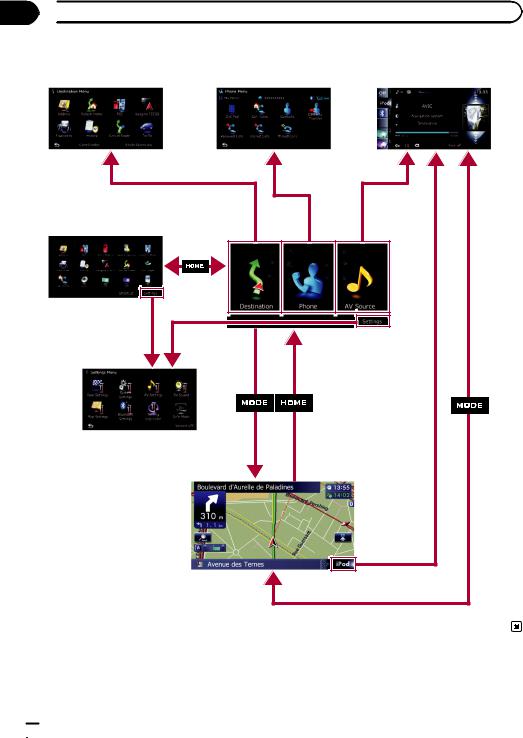
Chapter
03 How to use the navigation menu screens
How to use the navigation menu screens
Screen switching overview
2 |
3 |
4 |
1 |
|
1 |
|
|
5
6
 20
20 Engb
Engb
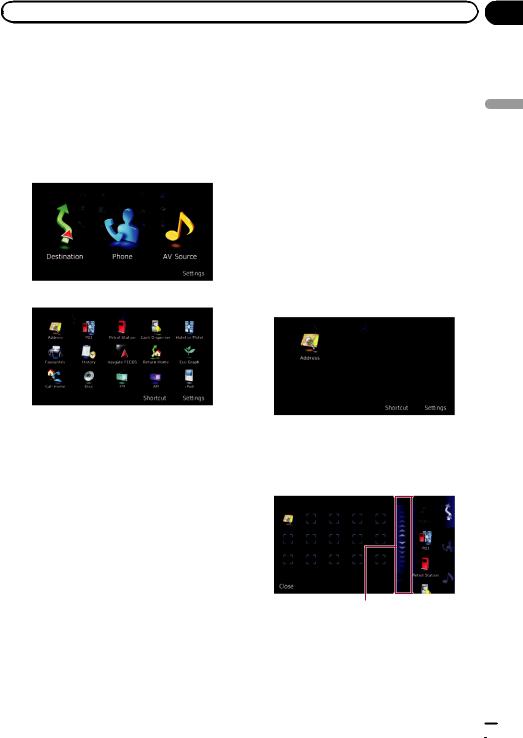
|
Chapter |
How to use the navigation menu screens |
03 |
What you can do on each menu
1Top Menu
Press the HOME button to display the “Top Menu” screen.
This is the starting menu to access the desired screens and operate the various functions. There are two types of the “Top Menu” screen.
Classic Menu
Shortcut Menu
pIn this manual, Classic Menu will be referred to as “Top Menu”.
2Destination Menu
You can search for your destination on this menu. You can also check or cancel your set route from this menu.
3Phone Menu
You can access the screen that is related to hands-free phoning to see call histories and change the settings on the Bluetooth wireless technology connection.
4AV operation screen
This is the screen that normally appears when you play the AV source.
5Settings Menu
You can access the screen to customise settings.
6Map screen
Press the MODE button to display the navigation map screen.
Shortcut Menu
Registering your favourite menu items in |
|
||
shortcuts allows you to quickly jump to the re- |
|
||
gistered menu screen by a simple touch on |
|
||
the Shortcut Menu screen. |
to How |
||
Selecting the shortcut |
|||
p |
Up to 15 menu items can be registered in |
use |
|
|
|||
|
shortcuts. |
the |
|
1 Press the HOME button repeatedly to |
|||
navigation |
|||
display the “Shortcut Menu” screen. |
|||
|
|||
|
p When you use the navigation system for the |
|
|
|
first time or no items are set on shortcut, a |
|
|
|
message will appear. Touch [Yes] to pro- |
|
|
|
ceed to next step. |
screensmenu |
|
2 |
Touch [Shortcut]. |
||
|
|||
The Shortcut selection screen appears.
3 Touch the tab on the right edge or scroll the bar to display the icon that you want to set to shortcut.
Scroll bar
4Touch and hold the icon that you want to add to shortcut.
5Move the icon to the left side of the screen, and then release it.
The selected item is added to shortcut.
Engb  21
21
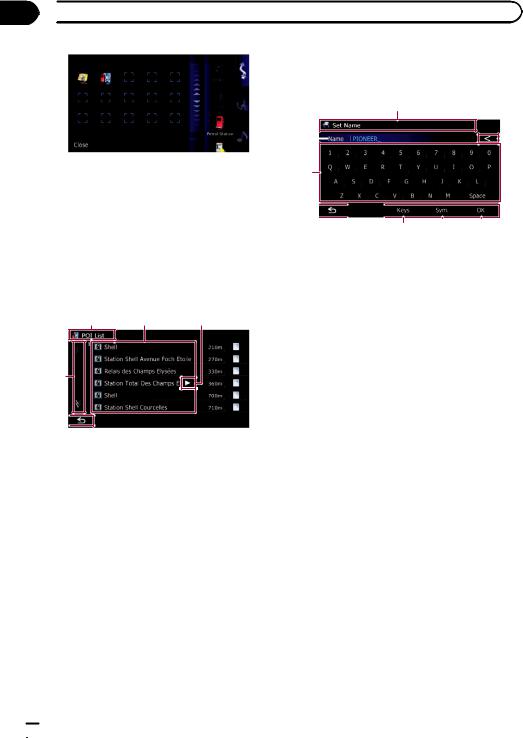
Chapter
03  How to use the navigation menu screens
How to use the navigation menu screens
Cancelling the shortcut
1Touch and hold the icon that you want to cancel the shortcut.
2Move the icon to the right side of the screen, and then release it.
Operating list screens (e.g. POI list)
1 4 5
2
3
1Screen title
2

Touching  or
or  on the scroll bar scrolls through the list and allows you to view the re-
on the scroll bar scrolls through the list and allows you to view the re-
maining items.
3
Returns the previous screen.
4Listed items
Touching an item on the list allows you to narrow down the options and proceed to the next operation.
5

If all of the characters cannot be displayed within the displayed area, touching the key to
the right of the item allows you to see remaining characters.
Operating the on-screen keyboard
1
2 |
|
8 |
3
4





 5 6 7
5 6 7
1Screen title
The screen title appears.
2Text box
Displays the characters that are entered. If there is no text in the box, an informative guide with text appears.
3Keyboard
Touch the keys to enter the characters.
4
Returns the previous screen.
5Keys
Switches the on-screen keyboard layout.
6Sym., Others, 0-9
You can enter other characters of alphabet. You can also enter text with marks such as [&] or [+] or numbers.
Touch to toggle the selection.
p When you use any of “A”, “Ä”, “Å”, “Æ”, the displayed result is the same.
7OK
Confirms the entry and allows you to proceed to the next step.
8
Deletes the input text one letter at a time, be-
ginning at the end of the text. Continuing to touch the button deletes all of the text.
 22
22 Engb
Engb
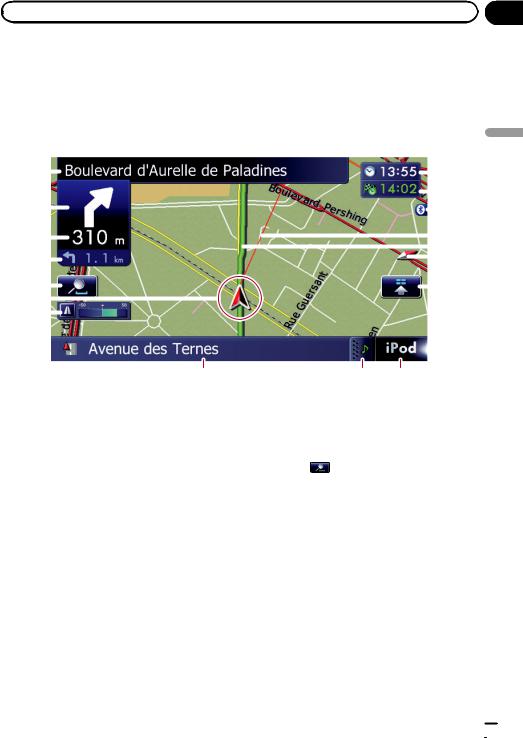
|
Chapter |
How to use the map |
04 |
Most of the information provided by your navigation system can be seen on the map. You need to become familiar with how information appears on the map.
How to read the map screen
This example shows an example of a 2D map screen. |
|
|
|
|
|||||||
1 |
|
|
|
|
|
|
|
|
|
|
h |
|
|
|
|
|
|
|
|
|
|
||
2 |
|
|
|
|
|
|
|
|
|
|
g |
|
|
|
|
|
|
|
|
|
|
||
|
|
|
|
|
|
|
|
|
|
f |
|
|
|
|
|
|
|
|
|
|
|
||
3 |
|
|
|
|
|
|
|
|
|
|
e |
|
|
|
|
|
|
|
|
|
|
||
|
|
|
|
|
|
|
|
|
|
|
d |
|
|
|
|
|
|
|
|
|
|
|
|
4 |
|
|
|
|
|
|
|
|
|
|
c |
|
|
|
|
|
|
|
|
|
|||
|
|
|
|
|
|
|
|||||
|
|
|
|
|
|
|
|
|
|
|
|
5 |
|
|
|
|
|
|
|
|
|
|
b |
|
|
|
|
|
|
|
|
|
|||
6 |
|
|
|
|
|
|
|
|
|
|
|
|
|
|
|
|
|
|
|
|
|
|
|
7 |
|
|
|
|
|
|
|
|
|
|
|
|
|
|
|
|
|
|
|
|
|
|
|
8 |
|
9 |
a |
p Information with an asterisk (*) appears |
Shows the turning direction after next and the |
||
only when the route is set. |
distance to there. |
|
|
p Depending on the conditions and settings, |
= For details, refer to Displaying man- |
||
some items may not be displayed. |
oeuvres on page 132. |
|
|
1 Name of the street to be used (or next gui- |
5 Zoom in/Zoom out |
|
|
dance point)* |
Touching |
displays touch panel keys for |
|
2 Next direction of travel* |
changing the map scale and the map orienta- |
||
When you approach a guidance point, this |
tion. |
|
|
item appears. |
6 Current position |
|
|
As you get closer to the guidance point, the |
Indicates the current location of your vehicle. |
||
colour of the item changes to green. |
The apex of the triangular mark indicates your |
||
p Touching this item enables you to hear |
orientation and the display moves automati- |
||
the next guidance again. |
cally as you drive. |
|
|
p You can select between display and |
p The apex of the triangular mark is the |
||
non-display. |
proper current position. |
||
= For details, refer to Displaying man- |
7 Eco-Meter |
|
|
oeuvres on page 132. |
Displays a graph comparing the past average |
||
3 Distance to the guidance point* |
fuel mileage and the average fuel mileage |
||
Shows the distance to the next guidance |
since the navigation system was last started. |
||
point. |
= For details, refer to Displaying the fuel |
||
p Touching this item enables you to hear |
consumption information on page 132. |
||
the next guidance again. |
8 Street name (or city name) that your vehi- |
||
4 Second Manoeuvre Arrow* |
cle is travelling along |
|
|
map the use to How
Engb  23
23
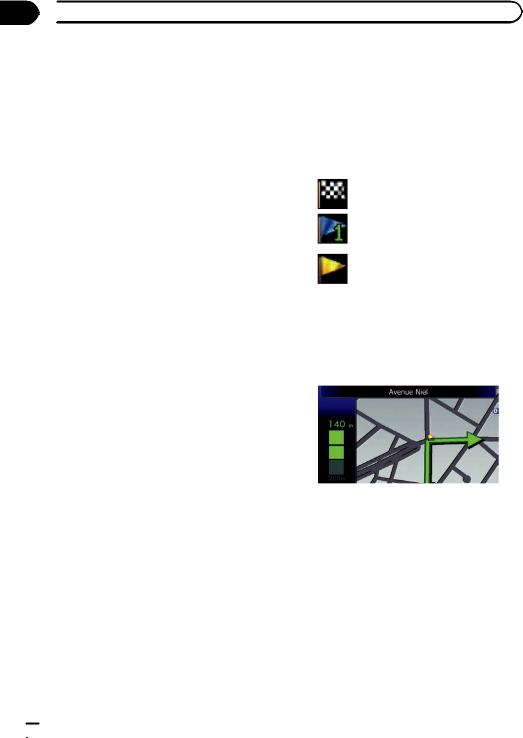
Chapter
04  How to use the map
How to use the map
=For details, refer to Setting the current street name display on page 131.
9Extension tab for the AV information bar
Touching this tab opens the AV information bar and enables you to briefly view the current
status on the AV source. Touching it again retracts the bar.
aShortcut to the AV operation screen
The AV source currently selected is shown. Touching the indicator displays the AV operation screen of the current source directly.
p If you connect your iPod to this navigation system, the artwork for the album that is playing appears.
bQuick Access icon
Displays the “Quick Access” menu.
=For details, refer to Setting the “Quick Access” menu on page 26.
cMap orientation indicator
! When “North up” is selected,  is displayed.
is displayed.
! When “Heading up” is selected,  is displayed.
is displayed.
p The red arrow indicates north.
dCurrent route*
The route currently set is highlighted in colour on the map. If a waypoint is set on the route, the route after the next waypoint is highlighted in another colour.
eDirection line*
The direction towards your destination (next waypoint, or cursor) is indicated with a straight line.
fBluetooth connection icon
This icon shows whether the device featuring Bluetooth technology is connected or not. You can select between display and non-display.
=For details, refer to Displaying the Bluetooth connection icon on page 131.
gMulti-Info window
Each touch of [Multi-Info window] changes the display information.
! Distance to the destination (or distance to waypoint)*
! Estimated time of arrival at your destination or waypoint*
The estimated time of arrival is an ideal value calculated based on the value set
for “Average Speed” and the actual driving speed. The estimated time of arrival is only a reference value, and does not guarantee arrival at that time.
!Travel time to your destination or waypoint*
h Current time
Meaning of guidance flags
Destination
The checkered flag indicates your destination.
Waypoint
The blue flags indicate your waypoints.
Guidance point
The next guidance point (next turning point, etc.) is shown by a yellow flag.
Enlarged map of the intersection
When “Close Up View” in the “Map Settings” screen is “On”, an enlarged map of the intersection appears.
=For details, refer to Setting the auto-zoom display on page 129.
 24
24 Engb
Engb
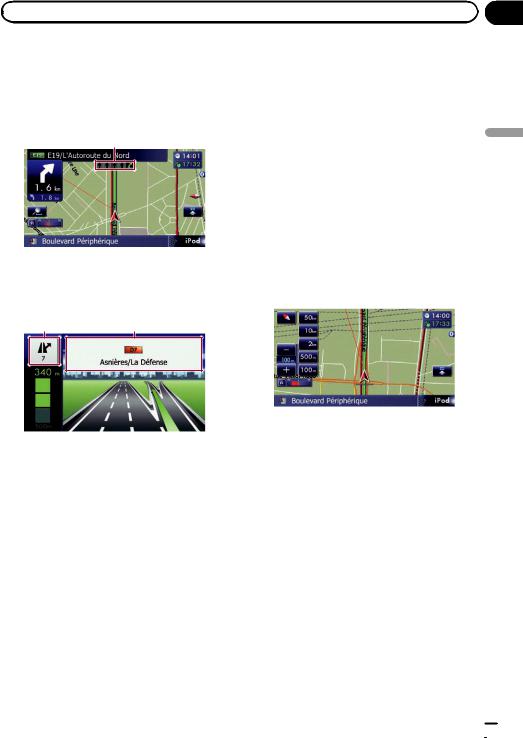
|
Chapter |
How to use the map |
04 |
Display during motorway driving
In certain locations of the motorway, lane information is available, indicating the recommended lane to be in to easily manoeuvre the next guidance.
1
While driving on the motorway, motorway exit numbers and motorway signs may be displayed when in the vicinity of interchanges and exits.
2 3
1Lane information
2Motorway exit information
Displays the motorway exit.
3Motorway signs
These show the road number and give direc-
tional information.
pIf the data for these items is not contained in the built-in memory, the information is
not available even if there are the signs on the actual road.
Roads without turn-by-turn instructions
Routable roads (the route displayed and highlighted in purple) have only basic data and can only be used to plot a navigable route. Pioneer Navigation will only display a navig-
able route on the map (only the arrival guidance for the destination or a waypoint is available). Please review and obey all local traffic rules along the highlighted route. (For your safety.)
Operating the map screen
Changing the scale of the map
You can change the map scale between 25 metres and 2 000 kilometres (25 yards and 1 000 miles).
1Display the map screen.
2Touch  on the map screen.
on the map screen.
 and
and  with the map scale appear.
with the map scale appear.
3 Touch  or
or  to change the map scale.
to change the map scale.
pIf you do not operate the function for a few seconds, the initial map screen automatically returns.
#Touch the direct scale key to change the map to the selected scale directly.
Switching the map orientation
You can switch how the map shows your vehicle’s direction between “Heading up” and “North up”.
!Heading up:
The map display always shows the vehicle’s direction as proceeding toward the top of the screen.
!North up:
The map display always has north at the top of the screen.
map the use to How
Engb  25
25
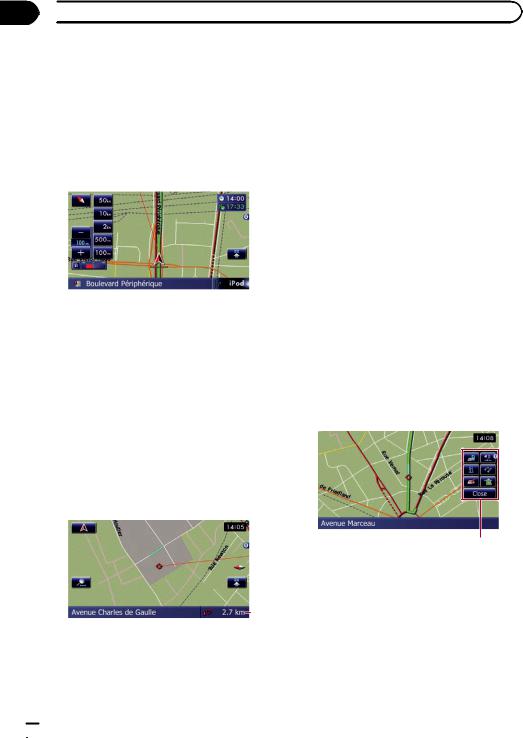
Chapter
04  How to use the map
How to use the map
pThe map orientation is fixed at “North up” when the map scale is 50 kilometres (25
miles) or more.
pThe map orientation is fixed at “Heading up” when the 3D map screen is displayed.
1Display the map screen.
2Touch  on the map screen.
on the map screen.
 or
or  appears.
appears.
screen, with street name and other information for this location being shown. (The information shown varies depending on the position.)
pThe scrolling increment depends on your dragging length.
#Touch  .
.
The map returns to the current position.
pPressing MODE button returns the map to the current position.
3 Touch  or
or  to switch the vehicle’s direction.
to switch the vehicle’s direction.
Each time you touch the key changes that setting.
pIf you do not operate the function for a few seconds, the initial map screen automatically returns.
Scrolling the map to the position you want to see
1Display the map screen.
2Touch and drag the map in the desired direction to scroll.
Setting the “Quick Access” menu
“Quick Access” menu allows you to perform various tasks, such as route calculation for the location indicated by the cursor or registering a location in [Favourites], faster than using the navigation menu.
You can customise “Quick Access” displayed on screen. The “Quick Access” described here are prepared as the default setting.
=For details, refer to Selecting the “Quick Access” menu on page 135.
pItems marked with an asterisk (*) cannot be removed from the Quick Access menu.
% When the map is displayed, touch  .
.
1
2
1Cursor
2Distance from the current position
Positioning the cursor to the desired location results in a brief informational overview about the location being displayed at the bottom of
Quick Access menu
 : Route Options*
: Route Options*
Displayed when the map is not scrolled. This item can be selected only during route guidance.
You can modify the conditions for route calculation and recalculate the current route.
=For details, refer to Modifying the route calculation conditions on page 41.
 : Destination*
: Destination*
 26
26 Engb
Engb
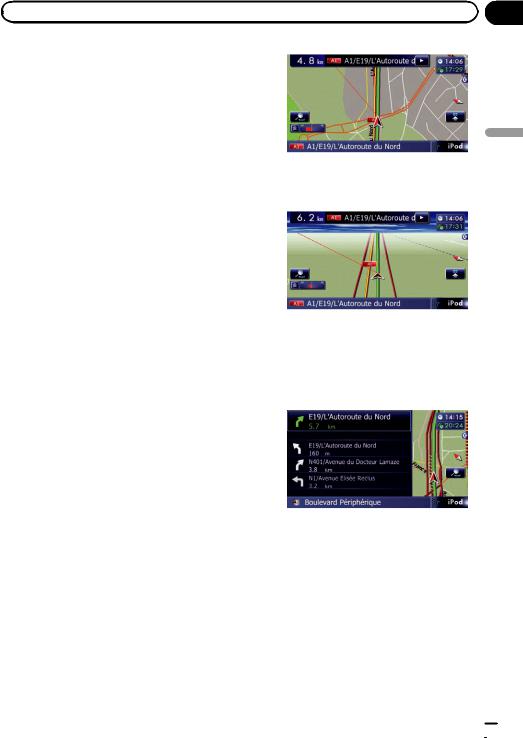
|
Chapter |
How to use the map |
04 |
Displayed when the map is scrolled. Set the route to the place specified with the cursor.  : Registration
: Registration
Register information on the location indicated by the cursor to “Favourites”.
=For details, refer to Registering a location by scroll mode on page 45.
 : Vicinity Search
: Vicinity Search
Find POIs (Points Of Interest) in the vicinity of the cursor.
=For details, refer to Searching for a nearby POI on page 36.
 : Overlay POI
: Overlay POI
Displays icons for surrounding facilities (POI) on the map.
=For details, refer to Displaying POI on the map on page 132.
 : Volume
: Volume
Displays the “Volume Settings” screen.
= For details, refer to Setting the Volume for Guidance and Phone on page 138.
 : Contacts
: Contacts
Displays the “Contacts List” screen.
=For details, refer to Calling a number in the
“Contacts List” on page 59.
Close
Hides the Quick Access menu.
Switching the view mode
Various types of screen displays can be selected for navigation guidance.
1Display the “Map Settings” screen.
=For details, refer to Displaying the “Map Settings” screen on page 129.
2Touch [View Mode].
The “View Mode” screen appears.
3 Touch the type that you want to set.
You can select the following types:
!2D View (default):
Displays a normal map (2D map).
! 3D View: |
How |
|
Displays a map with an aerial view (3D |
to |
|
map). |
||
map the use |
||
|
!Street View:
Information on the next four guidance points closest to the current location appear in order from top to bottom on the left side of the screen. The following information is displayed.
—Name of the next route to be taken by the vehicle
—Arrow indicating the direction of the vehicle
—Distance to the guidance points
pThis mode is available when the route is set.
!Rear View:
Displays the rear view image on the left side of the screen and the map on the right side of the screen.
Engb  27
27
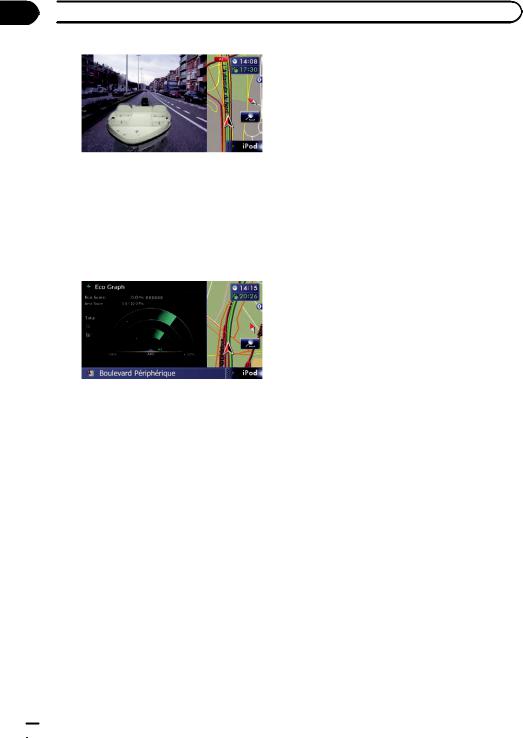
Chapter
04  How to use the map
How to use the map
pThis mode is available when [Camera] is set to “On”.
=For details, refer to Setting for rear view camera on page 140.
!Eco Graph:
Displays a graph for eco-driving on the left side of the screen and the map on the right side of the screen.
=For details, refer to Displaying “Eco Graph” on the next page.
 28
28 Engb
Engb
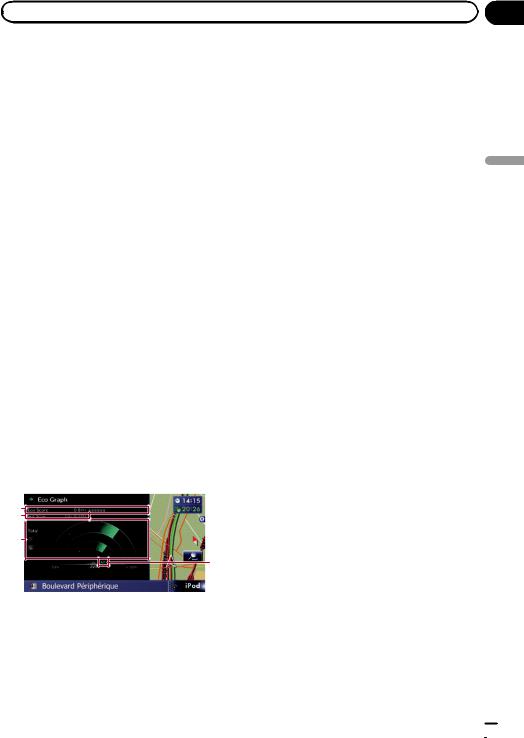
|
Chapter |
Eco-driving function |
05 |
This navigation system is equipped with an Eco-driving function that can be used to estimate whether you are driving in an environmentally friendly way.
This chapter describes this function.
pThe fuel mileage calculated is based on a theoretical value determined from vehicle speed and position information from the navigation system. The fuel mileage displayed is only a reference value, and does not guarantee the mileage displayed can be obtained.
Displaying “Eco Graph”
This function estimates approximate fuel mileage based on your driving, compares that with your average fuel mileage in the past, and displays the results in a graph.
The graph appears when the map display is set to “Eco Graph”.
1Display the “Map Settings” screen.
=For details, refer to Displaying the “Map Settings” screen on page 129.
2Touch [View Mode].
The “View Mode” screen appears.
3 Touch [Eco Graph].
The “Eco Graph” screen appears.
1
2
3
4
1Eco Score
The result of the comparison of your past average fuel mileage and current average fuel mileage appears as a value from 0.0 Pts (points) to 10.0 Pts. The higher the value, the better the fuel mileage when compared to past route guidance.
The green gauge indicates the current score, and the grey gauge indicates the best score to date.
The “Eco Score” is updated every 5 minutes.
p This is not displayed when “Eco Score” is set to “Off” or when no route is set.
2Best Score
Displays the best score to date.
p This is not displayed when “Eco Score” is set to “Off” or when no route is set.
3Average fuel mileage comparison graph
Displays a comparison of the average fuel mileage up to the point the navigation system was last stopped (past average fuel mileage) and the current average fuel mileage. The display is updated every 3 seconds. The more the value moves in the direction of +, the better the fuel mileage. There are three different graph bars.
!Total
A comparison of the past average fuel mileage and the average fuel mileage from the location the navigation system was last started to the current driving location.
! : Ordinary Road
: Ordinary Road
A comparison of the past average fuel mileage and the average fuel mileage for 90 seconds in the past, while the vehicle is driving on an ordinary road.
! : Motorway
: Motorway
A comparison of the past average fuel mileage and the average fuel mileage for 90 seconds in the past, while the vehicle is driving on a motorway.
4Animal icons
The number of displayed animal icons increases or decreases according to the value of “Eco Score”.
p This is not displayed when “Eco Score”
is set to “Off” or when no route is set.
pIf you try to use the “Eco Graph” function immediately after you start using the navi-
gation system for the first time,  may be displayed and the function may not be avail-
may be displayed and the function may not be avail-
able.
function driving-Eco
Engb  29
29

Chapter
05  Eco-driving function
Eco-driving function
= For details, refer to Troubleshooting on page 162.
p The display settings can be changed.
=For details, refer to Changing the eco-func- tion setting on page 128.
Sudden start alert
If the speed of the vehicle exceeds 41 kmph (25.5 mph) within 5 seconds from the time it is started, a message appears and a warning sound beeps.
Displaying Eco Drive Level guidance
This navigation system is equipped with the “Eco Drive Level” function that estimates how well you have driven in an environmentally friendly way.
The points of “Eco Drive Level” change according to “Eco Score” when the vehicle reaches the destination. When a certain number of points is reached, the level increases and a message appears.
1
1 Tree icon
As the level increases, a tree icon changes from a young tree to a big tree.
p This is not displayed when “Eco Drive Level” is set to “Off”.
=For details of the operation, refer to Chan-
ging the eco-function setting on page 128.
=For details of the operation, refer to Chan-
ging the eco-function setting on page 128.
 30
30 Engb
Engb
